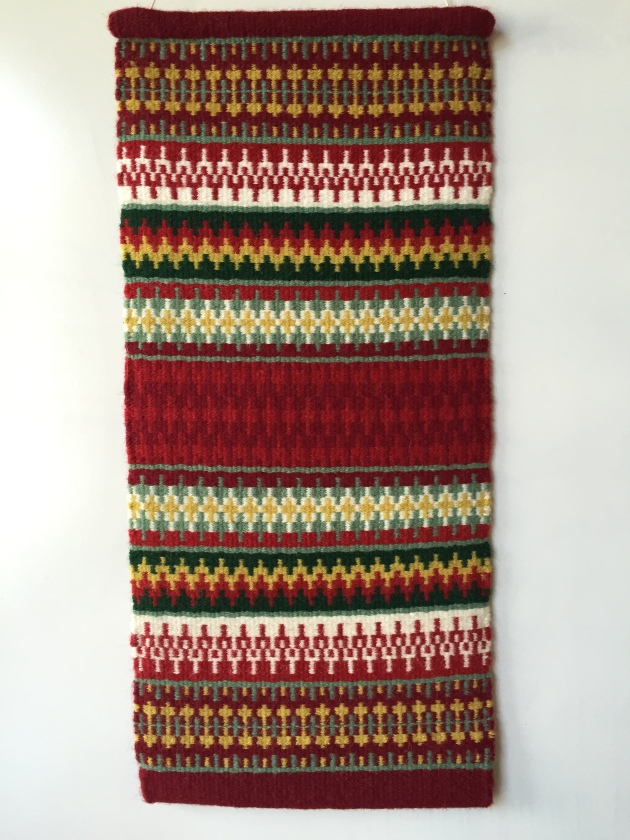“American Reboot” Co-curators Pop-Up Show: Jan Mostrom
August 9, 2017 Leave a comment
There are fabulous weavings in the Norway House Galleri during the run of the “Traditional Norwegian Weaving: American Reboot” exhibit, but there are more in Norway House atrium area, too–a pop-up exhibit of weaving by the co-curators, Jan Mostrom and Robbie LaFleur. This post features Jan’s weavings, and begins with her background.
I started weaving in a January term at Luther College in Decorah, Iowa when I was twenty years old. I was fortunate to have Lila Nelson as my first teacher and to have her continue as a mentor through the Scandinavian Weavers Study Group. I have been an active participant in Scanweavers since its beginning over thirty years ago. Lila provided the thread to connect me to Vesterheim where I took many weaving classes from Norwegian instructors in their Folk Art program. I also have taken six textile tours with Vesterheim led by Laurann Gilbertson.
When I took my first weaving class at Vesterheim, I met Syvilla Bolson who became a lifelong friend and mentor. She encouraged me to teach weaving at Vesterheim where I have taught classes including rutevev, rya, krokbragd, danskbrogd, Vestfold technique and Norwegian west coast coverlet techniques. I have also taught at the Weavers Guild of Minnesota, a Michigan weaving conference and at the first Norwegian Textile Conference in Decorah. I organized the first study group through the Norwegian Textile Letter (NTL) for the exploration of danskbrogd and have participated in two more NTL study groups. I have been a frequent author of articles in the NTL on weaving technique. I have a great passion and love for researching and teaching weaving.
 “Folk Dance” by Jan Mostrom (NFS) hangs behind the desk where Galleri guests are greeted. Jan wrote, “I was inspired by a coverlet from Vesterheim that had both single point krokbragd and double point krokbragd. My weaving has single krokbragd borders with a double krokbragd center. The joyful colors reminded me of the spinning colors of Norwegian folk dancers. ”
“Folk Dance” by Jan Mostrom (NFS) hangs behind the desk where Galleri guests are greeted. Jan wrote, “I was inspired by a coverlet from Vesterheim that had both single point krokbragd and double point krokbragd. My weaving has single krokbragd borders with a double krokbragd center. The joyful colors reminded me of the spinning colors of Norwegian folk dancers. ”

 Nearby is Jan’s “Northland” (NFS), a weaving in wool with rows of surprising rya knots — in reindeer skin. “I purchased a dyed red reindeer skin in north Norway on a Textile Tour to learn about the Sami culture of northern Scandinavia and Russia. This danskbrogd weaving of tree forms against a snowy white background has red leather rya knots. The colors, spare trees and reindeer leather remind me of Norway above the Arctic Circle.”
Nearby is Jan’s “Northland” (NFS), a weaving in wool with rows of surprising rya knots — in reindeer skin. “I purchased a dyed red reindeer skin in north Norway on a Textile Tour to learn about the Sami culture of northern Scandinavia and Russia. This danskbrogd weaving of tree forms against a snowy white background has red leather rya knots. The colors, spare trees and reindeer leather remind me of Norway above the Arctic Circle.”

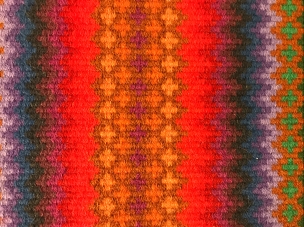
Jan’s long krokbragd weaving (NFS) was undertaken as a color study of brighter colors and values. The red sections have a glowing fire aspect.

Jan Mostrom explains her weaving “Garden Path.” ($1000, 50″ x 27″) “I wanted to create a non-traditional rutevev design that was colorful and whimsical. Garden Path was the result. It is heavy enough to use as a rug and also works on the wall either vertically or horizontally. The tapestry was woven with butterflies made up of a heavy two ply rya yarn and a thinner single ply yarn. The diffference in texture adds texture and the surfaces of the two yarns reflect light differently to create a little twinkle.”

Finally, Jan’s “Forest Echos” (photo coming, NFS) features beautiful browns of nature. Her explanation is perfect for those weaver-viewers who might want to know, “How did she do that?” Jan wrote,
This boundweave piece had an irregular twill threading. I used danskbrogd, a pick up technique, to replace some areas of the pattern with the background color. For instance, if it was woven as threaded, there would be narrow columns of color between the arrow shapes at the top and bottom of the weaving. By using danskbrogd, I could remove those colored bars and cover that area with the background brown and allow the arrow points to dominate that area of the weaving. The irregular threading created a repeated pattern that reminded me of echos, while the colors spoke of the forest to me.
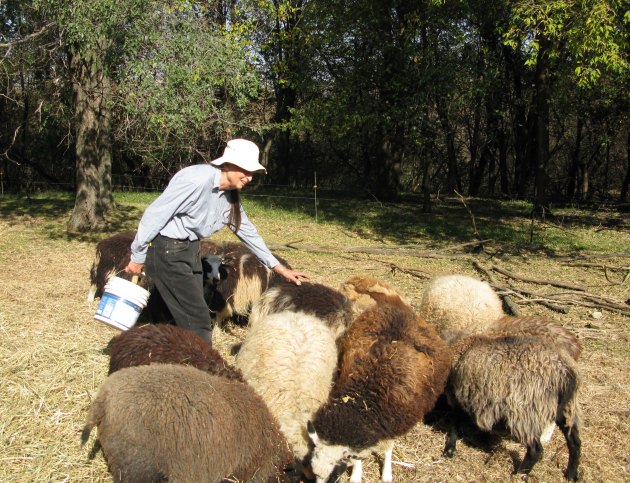
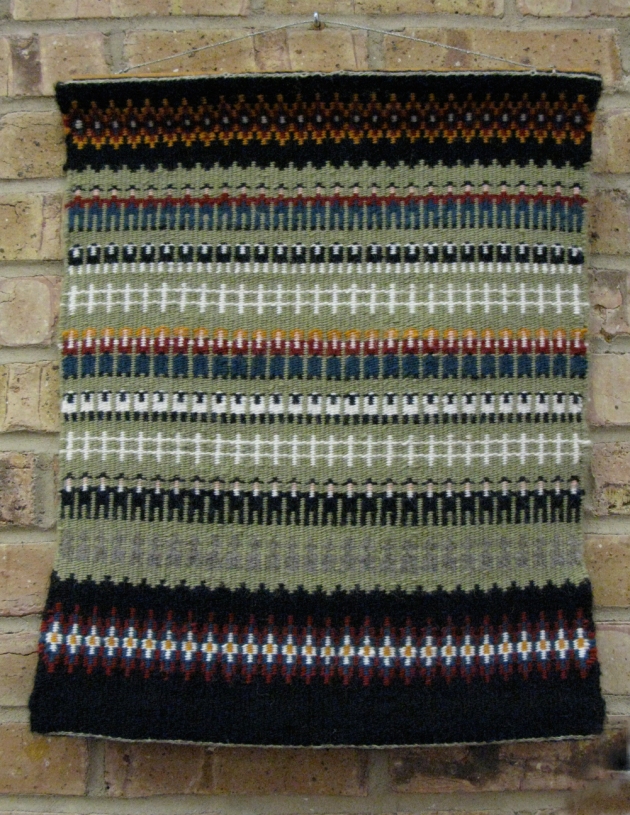
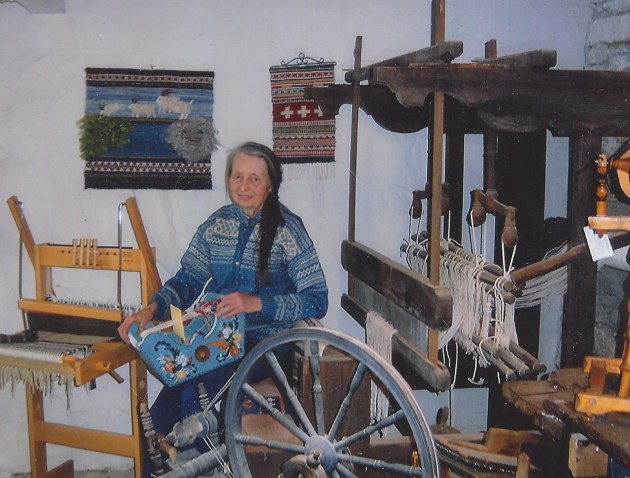



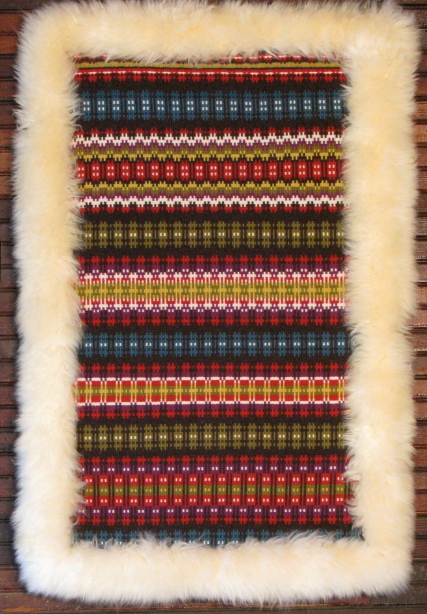 By Robbie LaFleur
By Robbie LaFleur
